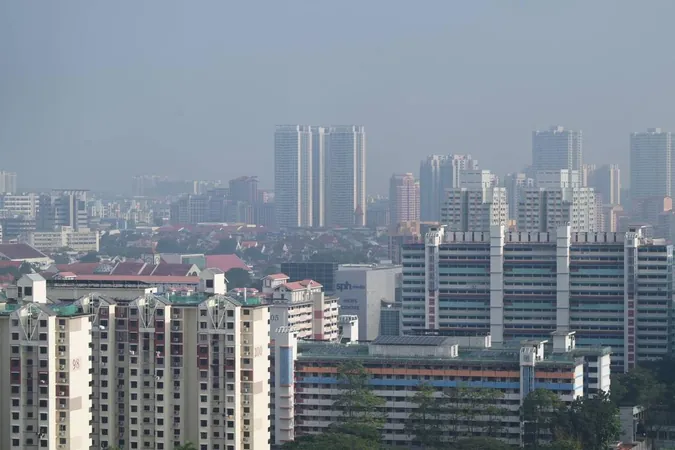
Singapore Faces Haze Crisis from Particulate Matter; Relief on the Horizon as Winds Strengthen
2025-03-26
Author: Rajesh
Hazy Conditions in Singapore
On the morning of March 26, hazy conditions blanketed Singapore, primarily attributed to an accumulation of particulate matter due to light winds. A representative from the National Environment Agency (NEA) indicated that conditions are likely to improve as winds strengthen later in the day.
Current Weather Patterns
Currently, Singapore is experiencing its north-east monsoon season, characterized by winds predominantly originating from the north-west or north-east. Although there has been a noticeable increase in hot spots and smoke haze in the Mekong sub-region, the NEA confirmed through satellite observations that there are no significant signs of smoke plumes drifting towards Singapore from those areas.
Impact of the Mekong Sub-region
The Mekong sub-region includes several countries such as Cambodia, Myanmar, Thailand, Vietnam, and Laos, where dry weather has led to deteriorating air quality. Earlier, on March 17, the Asean Specialised Meteorological Centre (ASMC) warned of a high risk of severe transboundary haze developing in the region due to significant hot spot activities stemming from prolonged dry conditions.
Pollutant Standards Index Readings
Data from the NEA indicated 24-hour Pollutant Standards Index (PSI) readings fluctuated between 63 and 77 by 2 PM, marking the first occasion since January 15 that these levels have been surpassed. Notably, one-hour PM2.5 readings remained at acceptable levels. PM2.5 is the primary pollutant of concern during episodes of transboundary haze.
Health Implications and PSI Recommendations
To put this into perspective, a PSI reading ranging from 51 to 100 is considered moderate. Under these conditions, the public is typically advised that it’s safe to continue daily activities. However, when the PSI falls between 101 and 200, the air quality is deemed unhealthy, prompting recommendations for vulnerable groups—including the elderly, pregnant women, and children—to limit outdoor activities.
Rise in Hot Spot Activity
Furthermore, satellite data uncovered 2,177 and 1,941 hot spots in the Mekong sub-region on March 15 and 16, respectively. This notable uptick in hot spots is alarming, especially when compared to the 164 and 335 hot spots identified at the start of the dry season in early January.
Widespread Smoke Haze Reports
The ASMC has reported widespread moderate to dense smoke haze affecting large areas in Myanmar, along with parts of northern Thailand, Laos, and Vietnam. Continuous dry weather is predicted, with only slight rain expected in southeastern regions. This sets the stage for potentially intensified haze activity, raising concerns about increased transboundary haze risks.
Public Awareness
Locals, like Mr. Chong, a 35-year-old tuition teacher, are becoming increasingly aware of the situation. Initially mistaking the haze for a foggy lens, he later realized the skies were affected after seeing discussions online. 'If it gets worse, I'll be turning on the air conditioner and staying indoors until it clears up,' Mr. Chong shared.
Outlook for the Future
As the NEA continues to monitor the evolving situation, residents remain hopeful for an imminent return to clearer skies as stronger winds roll in—offering a silver lining amid the haze crisis looming over Southeast Asia.



 Brasil (PT)
Brasil (PT)
 Canada (EN)
Canada (EN)
 Chile (ES)
Chile (ES)
 Česko (CS)
Česko (CS)
 대한민국 (KO)
대한민국 (KO)
 España (ES)
España (ES)
 France (FR)
France (FR)
 Hong Kong (EN)
Hong Kong (EN)
 Italia (IT)
Italia (IT)
 日本 (JA)
日本 (JA)
 Magyarország (HU)
Magyarország (HU)
 Norge (NO)
Norge (NO)
 Polska (PL)
Polska (PL)
 Schweiz (DE)
Schweiz (DE)
 Singapore (EN)
Singapore (EN)
 Sverige (SV)
Sverige (SV)
 Suomi (FI)
Suomi (FI)
 Türkiye (TR)
Türkiye (TR)
 الإمارات العربية المتحدة (AR)
الإمارات العربية المتحدة (AR)